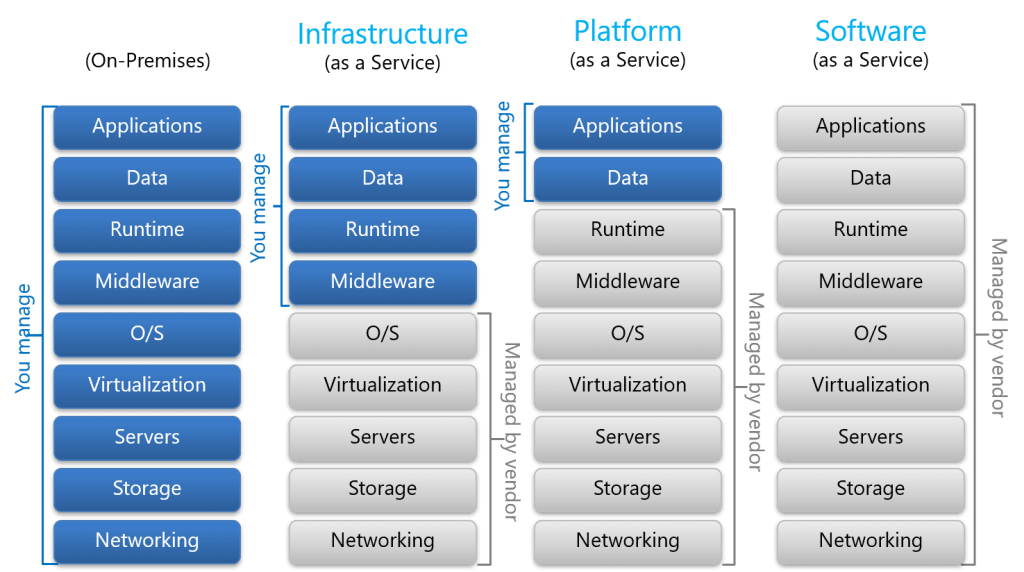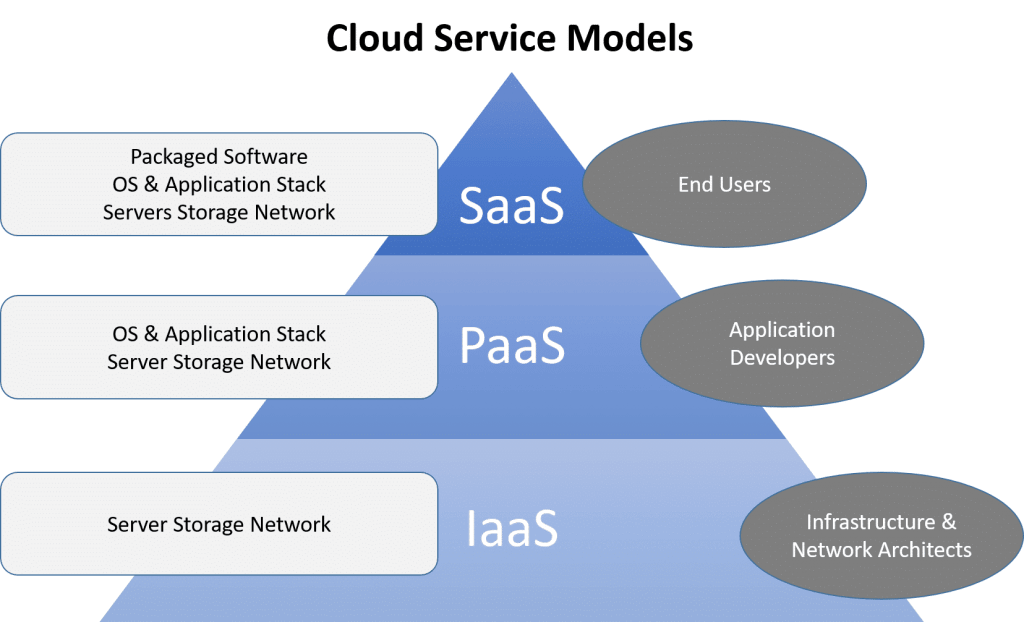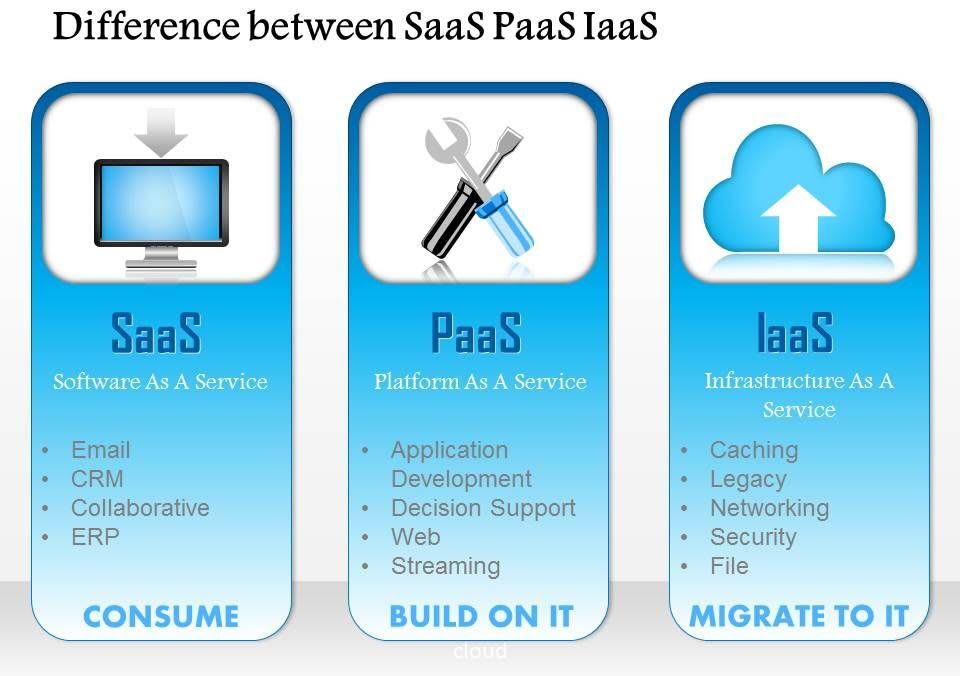SaaS vs PaaS vs IaaS: What’s The Difference and How Do You Choose?
Moving an Internet business to a cloud platform has flourished and gained prominence in the current industrial climate. Three main types of cloud computing service models are Software-as-a-Service (SaaS), Platform-as-a-Service (PaaS), and Infrastructure-as-a-Service (IaaS).
This article provides the difference between Saas, PaaS, and IaaS services and how to choose between them.

What is Software-as-a-Service (SaaS)?
Software as a service (or SaaS) solutions are applications or software easily accessible to end-users through the Internet. There is no need to maintain it because the service provider does this.
There are complexities associated with managing the software and hardware of any application that we use. However, SaaS resolves this overhead and offers ease of using the software through the Internet.
SaaS Examples
A few SaaS examples are:
- BigCommerce.
- Google Apps.
- Salesforce.
- Dropbox.
- MailChimp.
- ZenDesk.
- DocuSign.
- Slack.
- Hubspot.
Advantages of SaaS
Cost-effective
SaaS is typically delivered in a shared or multi-tenant environment where hardware and software license costs are lower than a traditional model, saving money. The SaaS provider owns the environment and divides it among all clients who utilize the solution. The result is that maintenance expenses are also lowered.
Also, you can quickly increase your customer base because SaaS allows small and medium businesses to use software that they would not otherwise use due to expensive licensing costs.
Integration and Scalability
SaaS solutions are typically hosted in scalable cloud settings with integrations to other SaaS services. You won't need to acquire a new server or software like the traditional model. You merely need to enable a new SaaS product, and the SaaS provider will handle server capacity planning. You'll also have the ability to adjust your SaaS usage up and down based on your requirements.
Ease of Use
As they already include baked-in best practices and samples, SaaS services are simple to utilize. Users can conduct proof-of-concept tests and test software functionality or a new release feature ahead of time. You can also have multiple instances with various versions and accomplish a seamless migration. Even for large environments, SaaS products are used to test the software before purchasing it.
Disadvantages of SaaS
Low Performance
Compared to a similar program operating on your employee's desktop, a browser-based application running on a faraway data center may be slower. Therefore, businesses should invest in a fast and dependable Internet connection and use application performance management tools to counteract this and track how their SaaS apps perform over time.
Connectivity Issues
Remotely working and accessing software puts you at risk of connectivity issues. If your home or business Internet connection is completely down, you lose access to the software. Some SaaS providers allow a degree of local storage, but you no longer have access to your data if that is not an option.
Insufficient Data Security
Security is one of the most common worries among businesses considering a SaaS-based application approach. Identification and access management issues need addressing before entrusting your company's sensitive data to any third-party service provider. In addition, implement rigorous procedures before providing sensitive data to a service provider, especially in the case of mobile access.
When to Use SaaS
SaaS services are comprehensive software solutions for rent from a cloud service provider on a pay-as-you-go basis. Some solutions are also available for license. Here are some examples of when a SaaS solution might be appropriate:
- Email Management.
- Calendar and Contact Management.
- Office Software (such as Microsoft Office 365).

What is Platform-as-a-Service (PaaS)?
Platform-as-a-Service (PaaS) is a cloud computing environment that creates a platform for development and application creation. Application developers use PaaS solutions to develop and manage applications without maintaining and administering the underlying infrastructure. Instead of superuser access, the provider limits users to the framework necessary to create their applications.
Example of PaaS
Here are some examples of PaaS services:
- Force.com.
- OpenShift.
- Apache Stratos.
- Magento Commerce Cloud.
- AWS Elastic Beanstalk.
- Heroku.
- Windows Azure.
Advantages of PaaS
Reduces the Coding Time
With pre-coded application components incorporated into the platform, such as workflow, directory services, security features, and search, PaaS development tools can reduce the necessary time to write new projects.
Multi-platform Development
Some service providers provide development options for many platforms, including PCs, mobile devices, and browsers, enabling faster and easier cross-platform app creation.
Sophisticated and Affordable Tools
Individuals and organizations can employ sophisticated development software, business intelligence, and analytics solutions that they couldn't afford to buy outright using a pay-as-you-go model.
Disadvantages of PaaS
Security
All application data is saved in the cloud database of the provider. However, this raises privacy concerns because providers can see private and sensitive information. Therefore, enterprises must safeguard their applications by partnering with a reputable vendor to mitigate risk.
Control
Some PaaS providers limit control of their platform. Depending on their capabilities, limitations exist as to what they allow. Some systems are more open to personalization or modification and often cater to more technically capable clients. Still, others are locked down and offer minimal opportunity to make a unique platform for your use case.
Compatibility
PaaS providers customize their infrastructure and platforms, potentially causing compatibility concerns. Additionally, developers interacting with a specific stack on an existing development platform may experience issues moving to a customized PaaS solution. Users must research thoroughly before choosing a service to ensure compatibility.
When to use PaaS
PaaS solutions are externally hosted environments designed for development and app creation. Developers choose the software stack and tools they need to create the services their clients need. Here are examples of when to use a PaaS environment:
- Data Management.
- Internet of Things (IoT).
- Business Intelligence.
- Application Programming Interface (API) Development and Management.

What is Infrastructure-as-a-Service (IaaS)?
Infrastructure as a Service (IaaS) is a type of cloud computing that uses the Internet to deliver processing, storage, and networking resources on a pay-as-you-go basis. Along with SaaS and PaaS solutions, IaaS is one of the three primary categories of cloud computing services.
Examples of IaaS
Here are some examples of IaaS providers:
- Liquid Web.
- AWS EC2.
- Rackspace.
- Google Compute Engine (GCE)
- Digital Ocean.
Advantages of IaaS
Increased Performance
Increased performance is one of the more well-known advantages of IaaS. Your infrastructure is provided and supported by the IaaS cloud service provider of your choosing. A cloud provider's infrastructure is typically more stable, redundant, and resilient than what would be obtainable and financially feasible in an office setting.
Increased Security
Security should always be a priority in any aspect of your IT environment, but it is especially vital for infrastructure. Your business is at risk if your infrastructure is vulnerable. Most IaaS cloud service providers invest in their IT security operations to assure the safety and security of the data they manage. Many cloud providers have rigorous physical access rules, high floor arrangements, and numerous kinds of verification in place.
Increased Support for Disaster Recovery and Business Continuity
One of the most significant advantages of IaaS cloud computing is knowing that your infrastructure is prepared for worst-case scenarios. A total failure of your cloud infrastructure would be catastrophic, potentially costing a small fortune to repair or replace. Most IaaS cloud service providers keep servers in dedicated data centers with redundant power, cooling, and network access, offering peace of mind to business owners.
Disadvantages of IaaS
System Monitoring and Backup
While the provider monitors the physical infrastructure, your services running on the servers are not. Downtime and service interruption is inevitable without a built-in solution or monitoring plan to oversee your environment and services. Data loss is also possible if backups are not implemented to protect against failures or human error.
Security
As with system monitoring and backups, securing data is the user’s responsibility, and the infrastructure's security is in the provider's hands. Your data may be vulnerable to hacking and vulnerabilities. Businesses must be willing to accept responsibility for implementing security solutions or absorb losses associated with potential exploits.
Customization
IaaS solutions are usually limited to the configurations offered by the provider, resulting in limited customization. Dedicated servers are completely customizable, while IaaS plans offer standardization with defined CPU cores, memory, and disk space. Some opportunities exist for tweaking the infrastructure, but not as much compared to dedicated servers.
When to use IaaS
IaaS solutions allow tailoring your app's underlying hardware and software to your needs. Here are some examples of when to use an IaaS solution:
- Private cloud solutions for high performance computing.
- Development and production environments.
- High availability or clustered environments.
- Separated databases for security reasons.
SaaS vs PaaS vs IaaS: Which is Best ?
Enterprises require different cloud services based on their specific needs. SaaS, PaaS, IaaS computing services have their own set of advantages and disadvantages. Simply select the solution that best meets your requirements.
Liquid Web offers managed hosting options for your next endeavor. Contact our sales team to find out what’s right for you.
Related Articles:

About the Author: Geethika Gireesh
Gaby Gireesh has a degree in cybersecurity and has worked as a senior system engineer for three years. In addition, she has extensive experience in Linux administration and web hosting.
Our Sales and Support teams are available 24 hours by phone or e-mail to assist.
Latest Articles
In-place CentOS 7 upgrades
Read ArticleHow to use kill commands in Linux
Read ArticleChange cPanel password from WebHost Manager (WHM)
Read ArticleChange cPanel password from WebHost Manager (WHM)
Read ArticleChange the root password in WebHost Manager (WHM)
Read Article


